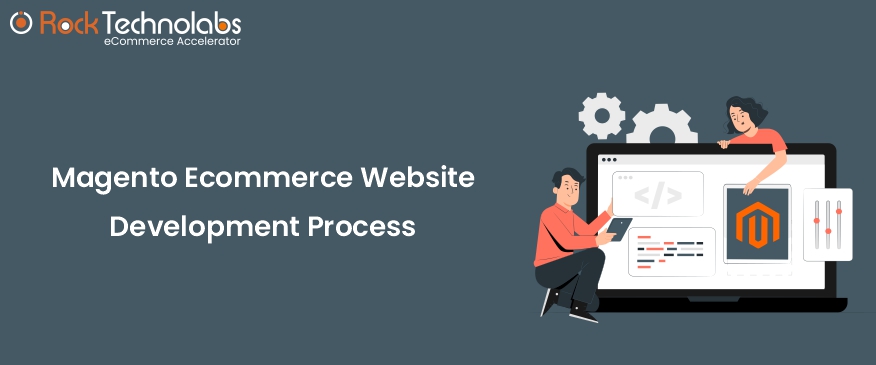What Steps Are Required For The Magento Ecommerce Website Development Process?

Online shopping is no longer just a comfort in this world of digitalization, it has become an art form and people expect seamless browsing, effortless checkout and lightning fast delivery.
Businesses need a powerful and scalable platform to stay competitive.
eCommerce website development nowadays is as easy as a breeze with popular and easy to use website development platforms such as Magento and elegant themes such as Hyvä.
Together, they help create spectacular Magento eCommerce websites which are robust, fast, and convenient to manage and scale.
Magento ecommerce development is known for its flexibility, extensive features, and customization capabilities.
But how do you navigate the intricate process of Magento ecommerce website development to build a store that stands out?
It does not matter whether you are a new entrepreneur pondering on how to create e-commerce with Magento 2 or an expert developer busy refining the Magento development skills; this detailed article will take you through steps, from planning to optimization after going live.
This guide will walk you through the latest trends, detailed steps, expert insights, and essential tips to ensure your Magento store development journey is smooth, efficient, and future-proof.
Let’s start!
Advantages of Creating a Magento-based eCommerce Website
- Customizable: Tailor each aspect of your store, from design to functionality, to fit the unique business needs.
- Scalability: The ability to easily handle growth in traffic and product catalogs with your growing business.
- Open Source Flexibility: It offers full features without a licensing cost, which suits startups.
- Advanced SEO Features: Built-in tools for optimizing URLs, meta tags, and sitemaps to maximize search rankings.
- Mobile Friendly Design: A responsive seamless shopping experience through all devices.
- Extensive Extension Marketplace: Thousands of extensions are available to add feature payments, shipping, marketing tools
- Multi Store Management: Management of multiple stores, languages, and currencies within a single dashboard
- Strong Security: Advanced security such as 2FA; regular security patches.
- Powerful Performance: Supports caching, CDN integration, and optimized databases for fast load times.
- Flexible Product Management: Easily manage different product types like simple, configurable, virtual, and bundled products.
- Comprehensive Analytics: In depth reporting and integration with tools like Google Analytics and Magento BI for data driven decisions.
- Global Reach Capabilities: Multi language and multi currency support for businesses targeting international markets.
- Seamless Integration: Connect with ERP, CRM, payment gateways, and third-party tools effortlessly.
- Community and Support: Backed by a large developer community and official Adobe support for continuous improvements.
- B2B and B2C Flexibility: Magento caters to both B2B and B2C businesses, offering tailored solutions for each.
Step-By-Step Guide For Developing Ecommerce Website Using Magento
Below we have listed 8 steps on how to create ecommerce website in magento 2:
1. Planning and Requirement Analysis
Every successful Magento 2 website development project begins with a clear roadmap. Before diving into Magento ecommerce website development, outline your business goals, target audience, and key features.
Key Actions:
- Identify target audience, product range, and unique selling propositions.
- Define essential features like payment gateways, shipping methods, and marketing tools.
- Set clear objectives for scalability, design, and performance.
Example: If you’re targeting a global audience, include multi language and multi currency support.
Pro Tip: Create a detailed project brief to guide the Magento website development process.
Read Here: Unique Magento 2 Features List
2. Choose the Right Magento Edition and Hosting
Now, it’s time to Secure Your Digital Home, that mean your online store’s address:
Hosting & Edition
Magento offers two editions:
- Magento Open Source: Ideal for SMEs
- Adobe Commerce: Best for larger enterprises with advanced needs like B2B features, advanced analytics, and AI driven recommendations.
For hosting, consider Magento Commerce Cloud or third-party providers like AWS or Azure.
- Cloud hosting (Magento Commerce Cloud)
- Dedicated servers for full control
- Managed hosting for easier maintenance
3. Design and Customization: Magento Design Development
First Impression is the last impression so it does matter.
Magento ecommerce web development is incomplete without an intuitive, user centric design. Magento design development involves creating a user friendly interface that reflects your brand.
Key Actions:
- Select a pre-built theme or develop a custom Magento theme.
- Ensure responsive design for mobile and desktop.
- Focus on UX/UI best practices like streamlined navigation and optimized checkout.
Trend Alert: Minimalistic design with rich media like videos and 360-degree product views is gaining traction.
4. Magento Backend Configuration and Setup
This is where the magic of Magento site development happens.
Set up essential backend functionalities:
Key Actions:
- Product Catalog Management
- Customer and Order Management
- Payment Gateway Integration
- Shipping and Tax Configuration
Proper configuration ensures a smooth Magento ecommerce store development experience.
Pro Tip: Use Magento’s native SEO tools to optimize product pages for search engines.
5. Custom Module Development and Extension Integration
Power up your Magento 2 store by extending functionalities.
Magento’s modular architecture allows for high customization. Magento’s flexibility allows you to add features through extensions.
Whether it’s advanced SEO tools, marketing automation, or custom checkout processes, extensions enhance the Magento ecommerce web development process.
Key Actions:
- Develop custom Magento modules for unique business needs.
- Integrate extensions for marketing, analytics, or advanced search.
Popular Extensions: Google Analytics 4 (GA4), MageAnt’s Layered Navigation, Google Rich Snippets
Explore our Magento B2B development services. Get seamless integrations, Drive growth, custom features and much more
6. Test the Website Thoroughly and Quality Assurance
Rigorous testing ensures your Magento online store development is free from bugs.
Focus on:
- Functionality Testing: Ensure all features work as intended.
- Performance Testing: Check load times and scalability.
- Security Testing: Validate data protection measures.
- Use automated tools for load testing and manual testing for UX.
Insight: Regular A/B testing post-launch can optimize conversion rates.
7. Deployment and Launch
Once testing is complete, deploy the website. Ensure a smooth launch by following a detailed deployment checklist.
Key Actions:
- Migrate data securely from staging to production.
- Monitor server performance and troubleshoot issues in real time.
- Gather user feedback for continuous Magento store development optimization.
As you move on with creating and setting up your Magento store, you would need a Magento Upgrade Service or Magento Migration Solutions.
8. Post-Launch Optimization and Maintenance and Updates
Magento 2 website development doesn’t stop at launch. Performance optimizations are necessary to maintain a competitive edge.
Key Actions:
- Regularly update the platform and apply security patches.
- Monitor analytics to optimize product listings, marketing campaigns, and UX.
You would also love to learn about our Magento Support and Maintenance Services
Expertise Required for Magento Store Development
Each step requires a different level of knowledge. As a result, the process of creating a Magento website frequently involves a large team of specialists.
- Magento Developers: Skilled in PHP, MySQL, and Magento architecture.
- UI and UX Designers: Focused on creating stunning and conversion optimized designs.
- DevOps Engineers: Manage hosting, server configuration, and deployment pipelines.
- Database Administrators: Handle data management, migration, and optimization.
- SEO and Digital Marketing Experts: Optimize site visibility and drive traffic through SEO.
- Quality Assurance Specialists: Conduct testing to ensure functionality and performance.
- Project Managers: Manage project timelines, resources, and team coordination.
- Security Experts: Ensure data protection, PCI compliance, and system security.
- Integration Specialists: Link Magento with ERP, CRM, and 3rd party systems.
Looking for any expertise on Magento, then Hire Magento Web Developers from our large pool of tech talent and get your job done.
The Future of Magento Website Development
- Headless Commerce: Seperate the frontend from the backend for flexibility in design and faster updates.
- Progressive Web Apps: Magento’s PWA Studio offers mobile app like experiences.
- AI and Personalization: Enhanced AI tools for personalized shopping experiences.
- Voice and Visual Search: Integration of advanced search capabilities to improve user experience.
- Cloud Native Solutions: Increased adoption of cloud infrastructure for scalability, security, and performance improvements.
- Global Expansion Features: Tools for multi language, multi currency, and localized ecommerce growth.
Read More: How Much Does A Magento Website Cost
Tips for Successful Magento Website Development
- Plan Thoroughly: Define clear goals, target audience, and required features before starting.
- Choose the Right Edition: Select between Magento Open Source or Adobe Commerce based on your business needs.
- Prioritize Performance: Use caching tools like Varnish and integrate a CDN to improve speed.
- Leverage SEO Tools: Optimize URLs, meta tags, and sitemaps using Magento’s built in SEO features.
- Implement Layered Navigation: Ensure easy filtering and finding of products for users.
- Use Quality Extensions: Add functionalities through trusted extensions but avoid overloading your site.
- Emphasize Security: Keep Magento up to date, apply security patches, and maintain PCI compliance.
- Test Thoroughly: Test functionally, on performance, and on security before launching.
- Optimize Checkout: Make the checkout process less complicated to reduce cart abandonment.
- Use Analytics: Leverage Magento BI and Google Analytics to track performance and customer behavior.
- Maintain it Ongoing: Update, optimize, and secure your store after launching.
- Make it Scalable: Design your store architecture to handle increased traffic and sales in the future.
Conclusion
Ready to start your Magento journey in 2025? It’s time to make your ecommerce concept a reality!
By following the methods given in this Magento eCommerce blog, leveraging professional insights, and staying ahead of trends, you can build an online business that not only fulfils current market demands but also has room for future expansion.
The path to a successful professional eCommerce website development process begins with defining your company’s needs and desired goals for your online store, followed by working with an experienced Magento 2 Development Company to create, launch, and promote a flawless online Magento store that generates endless business opportunities and the highest ROI.
We, the team at Rock Technolabs can surely help you with the full magento development process. If you want to grow your business faster, finding the correct partner to help you with Magento website development is crucial.
Need support or a consultant for your Magento 2 store? Get in touch.







